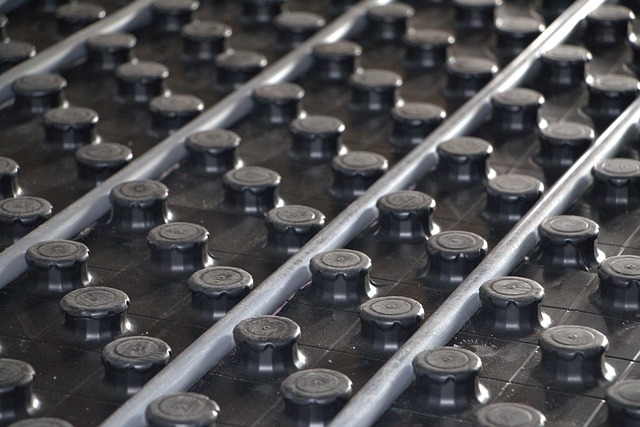Underfloor heating systems are popular for their efficiency and temperature control. They use hot water or electricity to heat pipes beneath floors, distributing heat evenly. Advantages include energy efficiency, reduced waste, minimal maintenance, and a comfortable environment. Compared to radiant heating, underfloor heating offers consistent warmth with fewer fluctuations, making it cost-effective. Underfloor specialists advocate for their system's superior energy efficiency through water circulation, smart thermostats, and renewable energy integration. While installation costs are higher, underfloor heating provides long-term savings and reduced maintenance. It's ideal for those seeking even warmth without cold spots, eco-conscious users, and environmentally friendly homeowners looking to reduce carbon emissions.
Considering a new heating system? Explore the battle between underfloor heating and radiant heating. This comprehensive guide breaks down the intricacies of each system, from how they work to their energy efficiency, cost, comfort, and environmental impact. Discover which option aligns best with your needs as an underfloor heating specialist, ensuring optimal warmth and value for your home.
- Underfloor Heating: How It Works & Advantages
- Radiant Heating: Basics and Key Features
- Energy Efficiency Comparison: Who Comes Out Top?
- Cost Analysis: Installation and Running Expenses
- Comfort and Control: User Experience Differences
- Environmental Impact: Eco-Friendly Considerations
Underfloor Heating: How It Works & Advantages

Underfloor heating systems have gained popularity for good reason. As a specialist in this field would attest, it’s a game-changer when it comes to efficient and comfortable indoor temperature control. This system works by circulating hot water or electricity through pipes installed beneath the floor, warming the entire space from the ground up. Unlike traditional radiators, which can leave cold spots and require constant adjustment, underfloor heating ensures an even heat distribution throughout the room.
One of the key advantages is its energy efficiency; it’s often more cost-effective than other heating methods as it heats the entire floor area directly, eliminating the need for multiple hot spots. This reduces energy waste, making it an eco-friendly choice. Moreover, how does underfloor heating work? is a question that many homeowners ask, but once installed, the system becomes virtually unnoticed, providing a comfortable environment without the need for frequent adjustments or maintenance—a significant advantage compared to electric floor heating methods.
Radiant Heating: Basics and Key Features

Radiant Heating: Unveiling the Basics and Key Features
Radiant heating is a type of heating system that operates by emitting heat through radiators or other sources, rather than relying on air circulation. Unlike traditional forced-air systems, radiant heating systems don’t distribute warm air throughout a space, but instead, warm objects and people directly. This method provides even heat distribution, ensuring every corner of the room is comfortable. For underfloor tiles, radiant heating is particularly appealing as it can be discreetly installed beneath flooring, creating a cozy ambiance while preserving the aesthetic appeal.
As an underfloor heating specialist would attest, one of the key features of radiant heating is its energy efficiency. It heats objects and people rather than the air, making it more efficient than forced-air systems. This not only reduces energy consumption but also minimizes the risk of temperature fluctuations and cold spots commonly associated with traditional heating methods. Moreover, when properly installed by an expert, radiant heating can offer long-term cost savings for homeowners, making it a popular choice among those looking to enhance their living spaces with comfortable and efficient underfloor heating solutions.
Energy Efficiency Comparison: Who Comes Out Top?

When comparing energy efficiency between underfloor heating and radiant heating, underfloor heating specialists often highlight its superior performance. This type of system circulates warm water through pipes embedded in the floor, evenly distributing heat throughout the space. As a result, it can maintain comfortable temperatures with lower overall energy consumption compared to radiant heating. The efficient design allows for better temperature control, minimizing heat loss and reducing the need for constant boiler repair or maintenance.
In terms of best underfloor heating systems, modern technology has made significant advancements in making them even more energy-efficient. Unlike traditional methods that rely heavily on a central boiler, contemporary underfloor heating can be integrated with smart thermostats and renewable energy sources like solar panels. This not only enhances the system’s overall performance but also contributes to a greener environment by reducing carbon footprint. Moreover, repairing underfloor heating leaks can be more straightforward than troubleshooting radiant heating’s complex infrastructure, making it an attractive option for those seeking long-term, low-maintenance solutions.
Cost Analysis: Installation and Running Expenses

When comparing underfloor heating against radiant heating, one of the most significant factors to consider is the cost analysis, specifically installation and running expenses. Underfloor heating specialists typically charge a higher upfront cost for the initial install due to the intricate work involved in laying pipes beneath the floor surface. This investment, however, can be offset over time as underfloor heating is renowned for its energy efficiency. Once installed, it costs relatively little to run compared to other systems, making it an economical choice for both residential and commercial properties.
In contrast, radiant heating systems may have lower initial installation costs but can involve additional expenses when replacing underfloor heating pipes over time. Radiant heat sources, such as tube or cable systems, often require periodic maintenance and repairs that can add up. Moreover, in cold climates where efficient warmth distribution is paramount, underfloor heating excels due to its ability to maintain consistent temperatures throughout the space, potentially reducing overall energy consumption and associated costs compared to radiant heating alternatives.
Comfort and Control: User Experience Differences

When it comes to comfort and control, underfloor heating and radiant heating offer distinct user experiences. Underfloor heating systems distribute heat evenly throughout a space via hot water flowing through pipes buried beneath the floor. This method provides consistent warmth, eliminating cold spots often associated with traditional heating systems. It’s particularly appealing to those seeking a quiet, seamless heating experience where the entire room feels cozy without harsh drafts or visible hardware.
Radiant heating, on the other hand, uses electricity to warm up panels or tubes embedded in floors or walls, emitting heat directly into the space. This technology offers precise control over temperature zones, allowing users to customize warmth levels in different areas of a home. While it may take some time for radiant systems to reach the desired temperature, once achieved, they maintain a comfortable environment with minimal noise and visible components. For underfloor heating specialists seeking eco-friendly underfloor heating solutions or top underfloor heating brands that prioritize energy-efficiency, radiant technology offers innovative options that cater to modern preferences for both comfort and control.
Environmental Impact: Eco-Friendly Considerations

Underfloor heating, as the name suggests, involves installing heating pipes or cables beneath the floor surface, offering a more uniform heat distribution compared to traditional radiators. This method is increasingly popular among underfloor heating specialists due to its energy efficiency and eco-friendliness. When comparing underfloor heating to radiators, the former typically uses less energy, as it heats the entire floor area rather than relying on convective air currents. As a result, it reduces the overall carbon footprint, making it an attractive option for environmentally conscious homeowners.
When considering underfloor heating for concrete floors, the process involves specialized installation techniques to ensure optimal performance and minimal environmental impact. The use of renewable energy sources, such as solar or geothermal heat, can further enhance its eco-friendliness. Moreover, the longevity of underfloor heating systems means fewer replacements and less waste, contributing to a more sustainable living space. Therefore, for those looking to reduce their carbon emissions, underfloor heating offers a compelling solution, especially when coupled with smart thermostats and energy-efficient appliances, marking a significant step towards a greener future.
When comparing underfloor heating and radiant heating, each has unique advantages. Underfloor heating offers a uniform heat distribution and energy efficiency, making it an attractive option for eco-conscious homeowners. Radiant heating, on the other hand, provides direct heat to surfaces, resulting in faster warmth and customizable temperature control. A specialist in underfloor heating may recommend their system for cost-effectiveness and ease of maintenance over the long term. Ultimately, the best choice depends on individual preferences, budget, and specific climate considerations.
